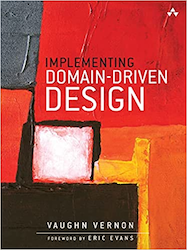- Tags:: 📚Books , DDD
- Author:: Vaughn Vernon
- Liked:: 6
- Link:: Amazon.com: Implementing Domain-Driven Design: 8601404568893: Vernon, Vaughn: Libros
- Source date:: 2013-02-06
- Finished date:: 2019-01-01
- Cover::

Why did I want to read it?
It is the perfect tactical companion for the strategic 📖 Domain Driven Design.
What did I get out of it?
DDD architectures
Traditional Layered Architecture

However, adhering to the definition of Layers may require implementations of some interfaces in the Domain Layer that depend on technologies provided by Infrastructure. For example, Repository interfaces require implementations that use components, such as persistence mechanisms, housed in Infrastructure. What if we just implemented the Repository interfaces in Infrastructure? Since the Infrastructure Layer is below the Domain Layer, the references from Infrastructure upward to Domain would violate the rules of Layers Architecture (…) This is not the only way to address this challenge, however. We might decide instead to implement such interfaces in the Application Layer, which would uphold the rules of Layers. (p. 122)
Hexagonal Architecture
The Dependency Inversion Principle is then an improvement on the Traditional Layered Architecture:

The essence of this definition is communicating that a component that provides low-level services (Infrastructure, for this discussion) should depend on interfaces defined by high-level components (for this discussion, User Interface, Application, and Domain) (p. 123)
Focusing on the Domain Layer, using DIP enables both the Domain and Infrastructure to depend on abstractions (interfaces) defined by the domain model (p. 125)
Interestingly enough, when we think about the influence that DIP has on this architecture, we might conclude that there are actually no longer any layers at all. Both high-level and low-level concerns are dependent only on abstractions, which seems to topple the stack. (p. 125)
Diagram:

We refer to this architecture by the name Hexagonal, even though its name seems to have changed to Ports and Adapters. Despite its changed name, the community still refers to it as Hexagonal. The Onion Architecture has also surfaced. How- ever, it appears to many that Onion is just an (unfortunate) alternate name for Hexagonal. We can safely assume that they are the same and stick with the [Cockburn] definition. (p. 125)
There is not a strict definition of what a Port means, making it a flexible concept. In whatever way Ports are partitioned, client requests arrive and the respective Adapter transforms their input. It then invokes an operation on the application or sends the application an event (p. 127)
We actually normally don’t implement the Ports ourselves. Think of a Port as HTTP and the Adapter as a Java Servlet or JAX-RS annotated class that receives method invocations from a container (JEE) or framework (RESTEasy or Jersey). Or we might create a message listener for NServiceBus or RabbitMQ. In that case the Port is more or less the messaging mechanism, and the Adapter is the message listener (p. 127)
The application receives requests by way of its public API. Thus, the application’s API is published as a set of Application Services (p. 127)
The entire application and domain model can be designed and tested before clients and storage mechanisms exist. Tests could be created to exercise ProductService well before any decision is made to support HTTP/ REST, SOAP, or messaging Ports. (p. 129)